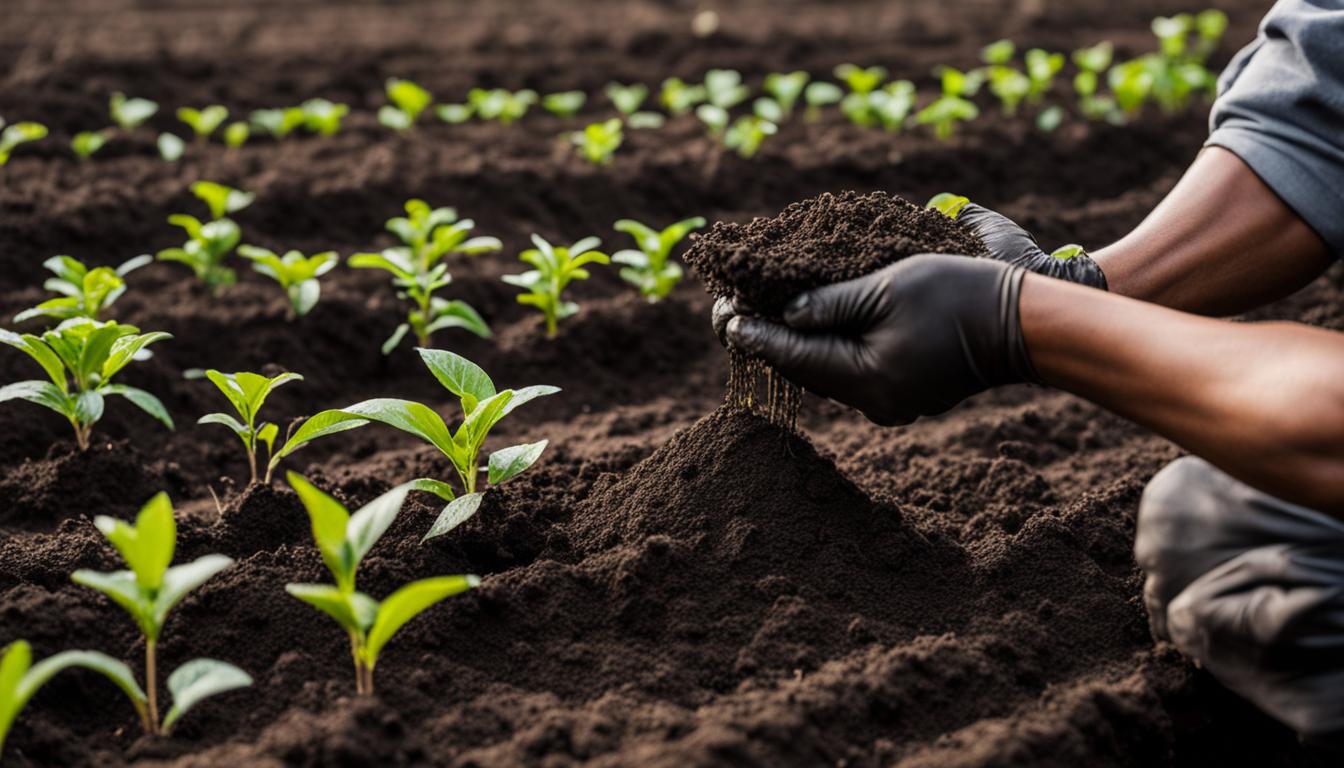Greetings tea enthusiasts! In today’s article, we delve into the essential practices of preparing soil for tea cultivation. Whether you’re a seasoned tea grower or a budding enthusiast, understanding the key strategies for soil preparation can make all the difference in cultivating vibrant tea crops. So grab a cup of your favorite brew, sit back, and let’s dive in!
India, the world’s second-largest tea producer, boasts a wide array of tea varieties with distinctive flavors. But to unlock the full potential of these flavors, we must start with the foundation – the soil. Tea plants thrive in well-drained acidic soil with a pH of 4.5 to 5.5 and an optimal temperature range of 20-27°C. Effective soil preparation involves plowing the land, applying rock phosphate and N:K fertilizer, and selecting the right planting density. Remember, tea cultivation is a long-term endeavor that requires careful soil management for optimal growth and production.
Key Takeaways:
- Tea cultivation requires well-drained acidic soil with a pH of 4.5 to 5.5.
- Plow the land twice and apply rock phosphate and N:K fertilizer for soil enrichment.
- Select planting density based on desired tea plant density.
- Proper soil preparation is essential for long-term tea crop success.
- Soil management is crucial for tea yield and quality.
Seed Selection and Treatment for Tea Cultivation
When it comes to tea cultivation, selecting the right seeds is crucial for success. We recommend choosing popular varieties that have been cultivated for many years, such as Pandian, Sundaram, Golconda, and Jayaram. These varieties have proven to thrive in a variety of growing conditions and produce high-quality tea.
Tea plants are commonly propagated through grafts and clippings. Cuttings are typically taken in April-May and August-September. Prepare semi-hardwood cuttings with one leaf and an internode. To ensure successful growth, it is important to treat the tea seeds properly. A common practice is binding the seeds with moss to speed up the healing process.
To propagate tea plants, nursery beds are prepared in shaded areas or with shade nets. The polythene bags used for propagation should be filled with a mixture of sand, loam, compost, MOP, magnesium sulfate, and zinc sulfate. This nutrient-rich mixture provides the necessary elements for healthy tea plant growth.
Overall, selecting the right tea seeds and properly treating them is essential for successful tea cultivation. By following these steps, tea growers can ensure that their plants have the best chance of thriving and producing high-quality tea.
| Important Steps for Seed Selection and Treatment |
|---|
| Select popular varieties: Pandian, Sundaram, Golconda, Jayaram |
| Take cuttings in April-May and August-September |
| Prepare semi-hardwood cuttings with one leaf and an internode |
| Treat seeds by binding them with moss |
| Prepare nursery beds in shaded areas or with shade nets |
| Fill polythene bags with a mixture of sand, loam, compost, MOP, magnesium sulfate, and zinc sulfate |
Land Preparation for Tea Cultivation
When it comes to tea cultivation, proper land preparation is essential for creating an optimal environment that promotes healthy growth and high-quality yield. The first step in land preparation is clearing the area of any debris or obstacles that may hinder the growth of tea plants. This ensures that the tea plants have ample space and resources to thrive.
Next, it is crucial to plow the land twice to prepare it for tea cultivation. This helps to loosen the soil, allowing for better root penetration and nutrient absorption by the tea plants. Additionally, the application of rock phosphate and N:K fertilizer at a ratio of 2:3 enriches the soil, providing the necessary nutrients for tea growth and production.
Different planting systems can be adopted depending on the desired density of tea plants. The single hedge system allows for wider spacing between plants, while the double hedge system increases planting density for optimal land utilization. These planting systems can be chosen based on the specific requirements and objectives of the tea plantation.
To summarize, land preparation for tea cultivation involves clearing the land, plowing it twice, and applying rock phosphate and N:K fertilizer. The choice of planting system depends on the desired density of tea plants. With proper land preparation, tea growers can create an ideal environment for tea cultivation, ensuring successful and sustainable tea production for years to come.
Soil Fertility Management in Tea Gardens
The success of tea cultivation relies heavily on effective soil fertility management. By implementing organic soil amendments, tea growers can improve soil health, enhance nutrient availability, and promote overall plant growth and productivity. Organic amendments, such as compost and well-decomposed organic matter, not only provide essential nutrients but also enhance water retention capacity and stimulate microbial activity in the soil.
Regular soil testing is a crucial step in soil fertility management for tea gardens. It helps in determining the nutrient levels and pH balance of the soil, allowing growers to make informed decisions regarding fertilizer application. Based on the soil test results, appropriate organic and inorganic fertilizers can be selected to meet the specific nutrient requirements of tea plants.
In addition to organic amendments and proper fertilizer application, mulching techniques can further contribute to maintaining soil fertility. Mulching tea gardens with organic materials, such as straw or wood chips, helps in conserving moisture, suppressing weed growth, and improving soil structure. The use of cover crops, particularly leguminous plants, can also enhance soil fertility by fixing atmospheric nitrogen and adding organic matter when incorporated into the soil.

Benefits of Soil Fertility Management in Tea Gardens
- Improved nutrient availability for tea plants
- Enhanced water retention capacity of the soil
- Increased microbial activity
- Conserved moisture through mulching
- Suppressed weed growth
- Enriched soil with organic matter through cover cropping
Effective soil fertility management is vital for sustainable tea cultivation. By implementing organic soil amendments, conducting regular soil testing, and utilizing mulching and cover cropping techniques, tea growers can ensure optimal soil health, leading to vibrant tea crops and higher productivity.
| Organic Amendments | Fertilizer Application | Mulching Techniques | Cover Cropping |
|---|---|---|---|
| Compost | Based on soil test results | Organic materials (e.g., straw, wood chips) | Leguminous plants |
| Well-decomposed organic matter | Organic and inorganic fertilizers | Conserves moisture | Improves soil fertility |
| Specific nutrient requirements | Suppresses weed growth | Provides organic matter |
Soil Erosion Control in Tea Cultivation
Tea cultivation often takes place on hilly slopes, making the soil susceptible to erosion. To ensure sustainable tea farming practices, it is crucial to implement effective soil erosion control techniques. By controlling erosion, we can preserve the topsoil, protect the tea plants’ root systems, and maintain the overall health of the tea plantation.
There are several techniques that can be employed to control soil erosion in tea cultivation. Terracing the land is an effective method that helps to slow down the flow of water and prevent soil runoff. By building contour trenches and bunds, we can redirect water flow along the contours, reducing the erosive force of the water.
Mulching tea plantations with organic materials is another effective soil erosion control technique. Applying a layer of straw or wood chips around the base of the tea plants helps to protect the soil surface from erosion. Additionally, it stabilizes the topsoil and regulates soil temperature, leading to improved soil health.

The Importance of Soil Erosion Control in Tea Cultivation
“Soil erosion control is crucial for sustainable tea cultivation. It preserves the topsoil, protects the tea plants’ root systems, and promotes the overall health of the tea plantation.”
Proper soil erosion control is essential to maintain the long-term sustainability of tea cultivation. It helps to prevent soil loss, retain valuable nutrients, and conserve water resources. By implementing these soil erosion control techniques, tea farmers can ensure the longevity and productivity of their plantations while preserving the natural environment.
| Erosion Control Technique | Benefits |
|---|---|
| Terracing | Slows down water flow, prevents soil runoff |
| Contour trenches and bunds | Redirects water flow along contours, reduces erosive force |
| Mulching with organic materials | Protects soil surface, stabilizes topsoil, regulates temperature |
Soil pH Adjustment for Tea Growing
Ensuring the proper pH level of the soil is essential for successful tea cultivation. Tea plants thrive in an acidic soil environment with a pH range of 4.5 to 5.5. When the soil pH is outside this range, it can hinder the availability of essential nutrients to the plants, impacting their growth and productivity. That’s why tea growers must actively manage and adjust the soil pH to create optimal conditions for tea cultivation.
To adjust the soil pH for tea growing, there are two main approaches: raising pH levels and lowering pH levels.
1. Raising pH Levels
If the soil pH is too low and acidic, lime can be applied to raise the pH level. Lime acts as a natural neutralizer, reducing soil acidity and bringing it closer to the desired range for tea cultivation. The amount of lime required will depend on the current pH level and the soil’s buffering capacity. It is important to conduct a soil test to determine the correct amount and type of lime needed for effective pH adjustment.
2. Lowering pH Levels
If the soil pH is too high and alkaline, sulfur or acidic fertilizers can be added to lower the pH level. These substances create a more acidic environment in the soil, helping to bring it within the optimal range for tea cultivation. Again, a soil test is crucial to determine the appropriate amount of sulfur or acidic fertilizers required for pH adjustment.
Regular monitoring of the soil pH is necessary to ensure that adjustments are made as needed. By maintaining the proper pH range, tea growers can provide an ideal growing environment for their tea plants, promoting healthy growth and maximizing yield.
| Benefits of Soil pH Adjustment for Tea | Challenges of Improper Soil pH |
|---|---|
|
|
“Maintaining the proper soil pH is like providing the sweet spot for your tea plants. It ensures they have access to the nutrients they need for robust growth and abundant production. With a little pH adjustment, we can create an environment where tea plants thrive and reward us with their flavorful leaves.”
Tea Cultivation Mulching Techniques and Cover Cropping
When it comes to tea cultivation, implementing effective mulching techniques and cover cropping can greatly contribute to soil health and overall plant growth. Mulching involves covering the soil around tea plants with organic materials, while cover cropping refers to the practice of planting specific crops alongside tea plants for additional benefits.
One popular mulching technique is the use of straw or wood chips, which helps retain moisture in the soil, regulate soil temperature, and suppress weed growth. By creating a protective layer around the base of tea plants, mulch also prevents soil erosion and increases organic matter content, improving soil fertility over time.
Additionally, cover cropping with leguminous plants can significantly enhance soil health in tea plantations. Legumes have the unique ability to fix nitrogen from the atmosphere, enriching the soil with this essential nutrient. When the cover crops are later incorporated into the soil, they contribute to organic matter content, improve soil structure, and promote beneficial microbial activity.
Benefits of Tea Cultivation Mulching Techniques and Cover Cropping
- Retains moisture in the soil
- Regulates soil temperature
- Suppresses weed growth
- Prevents soil erosion
- Increases organic matter content
- Enhances soil fertility
- Improves soil structure
- Promotes beneficial microbial activity
“Implementing mulching techniques and cover cropping in tea cultivation not only helps conserve moisture and suppress weeds but also enhances soil health, fertility, and overall plant growth. These practices contribute to sustainable tea production and support the cultivation of high-quality tea crops.”
By incorporating these practices into tea cultivation, growers can create a favorable environment for tea plants to thrive. Mulching and cover cropping not only benefit the plants directly but also contribute to long-term soil health and sustainability. With increased moisture retention, improved soil fertility, and reduced weed competition, tea farmers can expect healthier plants, higher yields, and enhanced quality in their tea production.
Mulching Techniques and Cover Cropping Recommendations
When it comes to mulching, using organic materials such as straw or wood chips is highly recommended. These materials are easily accessible, cost-effective, and provide excellent moisture retention and weed suppression. Apply a layer of mulch around the base of tea plants, ensuring it does not touch the stems or leaves directly.
For cover cropping, consider planting leguminous crops such as clover or vetch alongside tea plants. These crops have a symbiotic relationship with soil bacteria, allowing them to fix atmospheric nitrogen and enrich the soil. Incorporate the cover crops into the soil during the dormant season or before planting new tea plants to maximize their benefits.
Remember to monitor the mulch for thickness, as excessive mulch can create a moist environment that may favor the development of pests or diseases. Regular maintenance and adjustments are key to optimizing the benefits of mulching and cover cropping in tea cultivation.
| Mulching Techniques | Cover Cropping Recommendations |
|---|---|
| Use organic materials like straw or wood chips | Plant leguminous crops such as clover or vetch |
| Apply a layer around the base of tea plants | Incorporate cover crops into the soil during dormant season or before planting |
| Avoid direct contact with plant stems or leaves | Maximize nitrogen-fixing benefits |
| Monitor and adjust mulch thickness | Regular maintenance and adjustments |
Conclusion
After exploring the various aspects of soil preparation for tea cultivation, we can conclude that it plays a vital role in the success and productivity of tea crops. By following the key strategies discussed, tea growers can create an optimal environment for tea plants to thrive.
From selecting the right seeds and treating them properly to preparing the land and managing soil fertility, each step contributes to the overall health of the tea plantation. Controlling soil erosion, adjusting soil pH, and implementing mulching and cover cropping techniques further enhance soil quality and conserve moisture.
Regular soil health monitoring through soil testing is essential to assess nutrient levels and maintain the ideal pH balance for tea cultivation. This ensures that tea plants receive the necessary requirements for healthy growth and high-quality yield.
By prioritizing soil preparation and adopting sustainable practices, we can nurture vibrant tea crops, promote productivity, and contribute to the long-term sustainability of tea cultivation. So let’s dig in and prepare the soil for a flourishing tea journey!
FAQ
Why is soil preparation important for tea cultivation?
Soil preparation is crucial for tea cultivation as it creates an environment that promotes vibrant tea crops and enhances overall productivity and sustainability.
How do I select suitable tea seeds for cultivation?
It is recommended to choose popular varieties that have been cultivated for many years, such as Pandian, Sundaram, Golconda, and Jayaram.
What is the optimal pH range for tea plants?
The optimal pH range for tea plants is between 4.5 to 5.5. Adjustments can be made using lime to raise pH levels or sulfur and acidic fertilizers to lower pH levels.
How can I control soil erosion in tea cultivation?
Techniques such as terracing, contour trenches, and mulching with organic materials can help control soil erosion in tea plantations.
What are some soil fertility management strategies for tea gardens?
Applying organic amendments like compost, conducting regular soil testing, and using appropriate fertilizers based on nutrient requirements are key strategies for soil fertility management in tea gardens.
How can I adjust soil pH for tea growing?
Lime can be applied to raise pH levels, while sulfur or acidic fertilizers can be used to lower pH levels. It is essential to conduct a soil test to determine the exact requirements for pH adjustment.
What are the benefits of mulching and cover cropping in tea cultivation?
Mulching helps retain moisture, suppress weed growth, and regulate soil temperature, while cover cropping improves soil fertility by adding organic matter and fixing nitrogen.
Why is soil health monitoring important in tea cultivation?
Regular soil testing helps assess nutrient levels and pH balance, ensuring that the tea plants receive the necessary requirements for optimal growth and yield.





